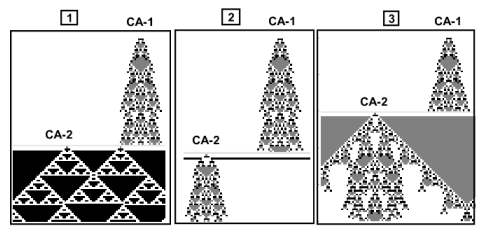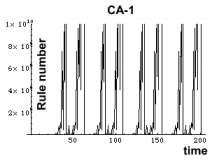 |
The CA process is specified by a triplet { state, rule, age limit }. Previous experiments demonstrated how the impact between CA processes controls state and age limit (v. Interaction). Nearly in all these experiments rule remained constant. The chapter on Evolution demonstrates how the state of one CA (Dominus) sets the rule of another one (Homo). We shall now proceed in the same vein.
A CA-1 zygote is planted. At a certain time
it is killed and its last state serves as a rule for a new zygote (CA-2)
which is planted after CA-1 death. In frame-1 the new rule is kept until
the end of the experiment. In
order examine the states of
the entire CA period, which is 46, the experiment was repeated 46
times. In each experiment CA-1 was killed at a different time, and its last state served as rule
for the new CA-2.. In most instances the outcome is biologically uninteresting,
like the one depicted in frame-1.
The next experiment was slightly modified.
After the CA-1 was killed and CA-2 planted, , the CA-1 rule controlled the CA-2 zygote only for one time unit, after which
the old rule (#600) was restored.
 |
The next graph depicts the rule numbers of the different CA-1 states.
 |
All processes in our body continually interact. Each
process state sets the rules for other processes. The context in which a particular CA exists depends
on the dimension of the entire process set. When a particular process
is perturbed, its response will depend on the state of the entire process
set. Suppose that we study
the effect of FSH on the ovary. We inject the hormone and watch how the
organism reacts to this perturbation. Since all processes contribute to
the outcome, it is difficult to appreciate what the specific effect of FSH
might be.
In the present model the rule stands for the effect of other processes on the CA.
The rule stands for the context of a CA. In order to simplify our
model the rule was kept constant, indicating that the model is isolated,
and its context narrow. The context might be broadened by allowing other CA states
to determine rules, like in
the above experiment. Or the rule may vary with time. In any case when modeling
a system we ought to specify its context.
1.
Material cause: CA structure, and age
2. Formal
cause: Its rule
3. Efficient
cause: Perturbation (injury)
4. Final
cause: Optimality
Here
the context is called Formal Cause.
When
Galileo studied falling objects, he was told that the Four Causes explain
best their behavior. Particularly the Final Cause according to which a stone
falls down in order to join mother earth. Galileo may have reasoned as follows: Let's assume that all
causes except the third are negligible, and formulate a theory based solely
on the Efficient Cause. At this point the exact sciences were born. This
reasoning paved the way for their astounding technological achievements.
Two
centuries later, medicine became enchanted by the great appeal of the exact
sciences. It therefore decided to reject the three causes, and keep the Efficient Cause. This is when
modern medicine was born.
Further reading: The four causes of disease
Context fallacy
The absolute devotion to the
Efficient Cause forced medicine to narrow the context of its studies.
Most theories of the medical sciences are based on experiments done in
vitro. They were then extrapolated to the complex organism as
if the context change does not matter. Like The
Central Dogma of Molecular Biology which was worked out in vitro, and is hardly valid within
the extended context of the organism. This and other context fallacies brought
about the conceptual confusion of
modern medicine.
Further reading:
Iatrogenic Medicine
Beware of the Gene
Cloning fallacy
Streaming Proteins
Setup
effect[1,500]; effect[2, 500]; a[[1, 50]]=0
; a[[1, 70]]=1; seedtime = mm; ruletime=mm +1; injurystate[1, j, mm, 60,
40, 0]; If[j == ruletime, rul[[1]]
= Take[a[[2]], {f[[2, 1]], f[[2, 2]]}];